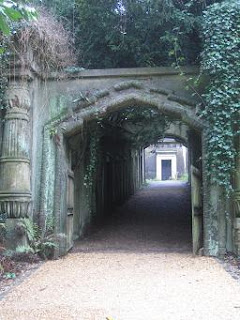On Saturday, we went to Highgate Cemetery where we took a guided tour of the West side. Highgate Cemetery is divided into two sections: the West and East sides. Most visitors go to the East side to see the graves of famous people, most notably Karl Marx. Our guide told us that tour buses full of people from former Communist countries often go to see Karl Marx's grave (and they like smoking a cigarette next to it too) and no one else.
Highgate Cemetery is perhaps also known for being the setting of Audrey Niffenegger's second and new book, Her Fearful Symmetry (2009). Niffenegger's first was the massively popular The Time Traveler's Wife, published in 2003 and turned into a motion picture this year. The setting is also used by Neil Gaiman in his critically-acclaimed The Graveyard Book (read my post on it here).
However, we decided to take a tour of the less-visited West side (Karl Marx, George Eliot, William Foyle, Douglas Adams and more will have to wait for another time...). There were only five people on our tour and we learnt a great deal from our young voluntary guide. Some of the things we learnt are summarised below:
1) The cemetery began as a private venture run by the London Cemetery Company. It opened in 1839 as one of many new commercial cemeteries designed to make money and solve the growing problems associated with London's overcrowded public burial grounds. For example, many corpses were stolen by body snatchers who sold the bodies to hospitals for medical research. The idea was that the cemetery, which was at that time located outside of the city, would be a quiet oasis for people to spend the afterlife. It was also an attraction that people came to visit during the weekends. They could admire the view of London from Highgate and hopefully be convinced to buy a plot. The company originally did well, but as spaces filled, the maintenance exceeded the profits. By the 1970s, the cemetery was in disrepair and was being vandalised.
2) Since the 1970s, the cemetery has been run by a charity, the Friends of Highgate Cemetery Trust (FoHCT). Especially on the West side, their policy is called 'managed neglect'. The effect is that the cemetery is largely overrun but still free of garbage. The organisation takes relative little initiative to restore the graves but it does trim back the trees and plants. This all gives the cemetery a rather Romantic feel, as if you were walking into a lost world.
 |
| The front gate to the West side of Highgate Cemetery |
3) The guide told us a lot about the symbolism and fashion statements associated with the graves. For example, on their graves, many people chose to have a Roman column which was severed at the top to symbolise a life cut short. This was then topped by a wreath to represent the triumph of the afterlife over our worldly existence.
4) The highlight of the tour may have been the Egyptian Avenue and the Circle of Lebanon. The Egyptian Avenue was originally designed to impress visitors and to exploit the interest in things Egyptian of the time.
As we walked along the Avenue, we saw many crypts which had holes in the doors for bats to come out in the evening. The Avenue led to the Circle of Lebanon, which must have been the centrepiece of the entire cemetery. They built the Circle around a huge tree which has only grown larger in the 150 years or so since it was built. Today, the Circle feels like a village of the dead:
 |
| Egyptian Avenue |
 |
| Bat holes |
5) One of the people buried in the Circle was the lesbian author Radclyffe Hall, who incidentally also went to King's College London. Hall is most well-known for her controversial novel, The Well of Loneliness, which has overt lesbian themes and was banned in both the UK and the US. She is buried with one of her lovers.
6) Above the Circle, we saw the grave of George Wombwell, who founded Wombwell's Travelling Menagerie, a kind of travelling zoo. He began his career when he bought two boa constrictors from the London Docks. He then began touring pubs with the snakes, a business which made him a good profit. From there he expanded to other animals. He had two lions, one of which was called Nero. Nero, famous for his docility, is featured on Wombwell's grave:
7) Also above the Circle, we were introduced to Julius Beer, a German investor in the nineteenth century. His mausoleum is the biggest and tallest in the cemetery. The guide seemed to think Beer, a self-made man and proprietor of The Observer, built such a large monument to make up for the fact that in his life time, he had not been well received in Victorian English society.
 |
| Julius Beer's Mausoleum |
 |
| Thomas Sayers, guarded by his faithful friend, Lion |
After visiting Highgate Cemetery, we went to the fashionable and hip Camdan Town. Surprise! I bought two clothing items, one of which was a discounted funky small jacket for cross-dressing purposes (kidding!). It's quite dashing.





































No comments:
Post a Comment